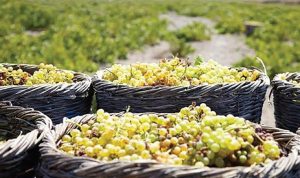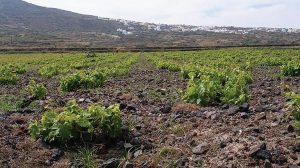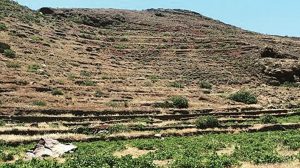Cover Story: Santorini’s Assyrtiko Takes On The World
Posted by estiator at 12 August, at 10 : 33 AM Print
BY CONSTANTINE N. KOLITSAS
IF EVER THERE WAS A “LITTLE WINE THAT SHOULDN’T,” IT’S SANTORINI’S ASSYRTIKO. MADE FROM A FEISTY EPONYMOUSLY NAMED GRAPE THAT HAS SOMEHOW MANAGED TO SURVIVE AND FLOURISH FOR MORE THAN 3,500 YEARS DESPITE INHOSPITABLE CONDITIONS, IT HAS ARGUABLY BECOME THE GLOBE’S MOST SOUGHT-AFTER RARE WHITE WINE.
OVER the past decade, Greek wines have been enjoying global acclaim on a scale unheard of since Homer waxed poetic about the Dionysian elixir that “gives strength to weary men.” And perhaps no indigenous varietal has garnered more praise from wine critics, oenosnobs, and casual quaffers than Assyrtiko from Santorini, the noble grape most closely associated with Greece’s most praised idyllic scenescape. And while it can’t be said that the nearly five million tourists to Santorini in 2018 came just for the wine, it’s certainly understandable that most of them left with an understanding of, if not a new passion for, this unique varietal.
If Greek yogurt was the catalyst for the world’s growing fascination with Greek foods, so it is that Santorni’s Assyrtiko has created interest in all wines Greek, buoying the entire industry on a global scale. Wine writer Konstantinos Lazarakis recognized this nearly 15 years ago in his highly regarded work, The Wines of Greece, writing that “Santorini has clearly emerged as the thoroughbred able to pull Greek wine out of anonymity.” For many wine professionals, he wrote, “Greek wine is Santorini and in terms of individuality of regional style…it belongs without a shadow of doubt in the top five.”

Indeed, Assyrtiko from Santorini is one of the most distinct wines on the planet, and for this reason, approximately 80 percent of the island’s vines are planted to the variety. Often held up as one of the great examples of “terroir” in the world (see “Traits of Terroir” for more explanation), the island’s unique terrain and climate create conditions that give the wine some of its most important characteristics: crisp acidity, full-bodied complexity, and a stony mineral finish.
Santorini’s terroir is a function of many factors: the number of sunshine hours it receives, the range of temper atures the climate experiences within a single day, and, of course, the island’s volcanic soil and subsoil. It is, in fact, pumice and sulfur from the volcano that transfer directly to the wine, producing a distinct and vexing minerality.
Furthermore, it’s from the pumice that the fruit obtains its water, absorbed of the moisture carried from the sea on the winds. Those elements combine to give Assyrtiko beautiful structure and personality.
Ted Diamantis of Diamond Wine Importers is among the first to bring Santorini Assyrtiko into the United States and has been championing the varietal for nearly two decades.
“Assyrtiko from Santorini is a miracle of man and nature,” he says, indicating the role that the island’s people have played. “Over the course of centuries, the locals have found ways to cultivate the grape in what should otherwise be some of the most inhospitable circumstances,” he says.
“The island, after all, gets just a few inches of rain each year,” he says, “while fierce winds blow so hard in spring and summer that most of the few trees found there grow bent at 90-degree angles.”
And it is because of the fierce winds that Assyrtiko vines on Santorini are pinned to the ground and trained into conical, basketlike weaves, known as “kouloura,” which provide the grapes shelter and contribute to their ability to conserve water.
Where the overwhelming majority of wine produced throughout the world today is from grafted vines, Assyrtiko wine grapes are “own-rooted.” Grafting became necessary in the late 19th century, when phylloxera (root lice) wiped out vineyards around the globe. New vines, then, were grafted onto rootstocks that were resistant to the louse. Today, just a few small pockets of vines are planted on their own roots, many of which are ancient vines that survived the epidemic. In the case of Santorini Assyrtiko, the pests could never survive in its ashy soils, which are absent of organic matter and the clay that the louse prefers. And when vines got too old (many date back as far as 400 years), the vintners on the island learned how to propagate their wines by shooting a cane straight into the earth to grow a new vine.
Diamantis sums it up well: “What we see on this island in the Aegean is terroir in the larger sense—the perfect coalescing of soil, climate, grape variety, and human cultivation to produce a wine that is sui generis [it could exist nowhere else].”
Over the past year or two, spiking demand has caused the prices of Assyrtiko from Santorini to rise significantly as demand has far outpaced the island’s capacity to supply wine from its celebrated grape. While low yields are partially the cause (a hectare of cultivated Assyrtiko on Santorini typically yields about 1,500 liters, or 2,000 bottles, whereas high-volume vineyards can produce 20 times more), the island’s tourism trade is both a blessing and a curse as more land is given over to accommodate annual visitors. In all, wines are grown on only 900 hectares of the island’s soil.
And while Assyrtiko originated in Santorini, the grape has (like the Greeks themselves) rooted itself in areas well beyond its birthplace, and even abroad. To satisfy demand, Diamantis’s company has expanded its offerings to include a few Assyrtiko labels produced off the island.
“Some of the best-selling Assyrtikos,” he says, “are produced in vineyards in Northern Greece, Peloponnese, and Crete, although they lack the distinct characteristics of their Cycladic cousin.”

While in many cases these are great wines, executed by immensely talented winemakers, he believes that they could never achieve the characteristics of Santorini-grown Assyrtiko, simply because the symbiotic relationship that has existed and still exists between the soils, climate, and variety cannot be replicated.
|TASTING NOTES|
Alexakis, Assyrtiko

VINEYARD LOCATION: Crete
COLOR: bright yellow with green hues
NOSE: passionfruit, mango, and citrus
PALATE: balanced with crisp acidity and characteristic minerality; long and lasting finish
PAIRINGS: seafood, light sauces
AWARDS, RATINGS: Wine Advocate, 87 points
Alpha Estate, Assyrtiko Single Block “Aghia Kiriaki” ECOSYSTEM

VINEYARD LOCATION: Amyndeon, Macedonia, Northern Greece
COLOR: crystal, bright sub-yellow; straw, with greenish hints
NOSE: citrus, floral, white stone fruits
PALATE: excellent structure, creamy and crisp with long and persistent finish
PAIRINGS: seafood, salads
AWARDS, RATINGS: Wine Advocate, 90 points
Boutari, Santorini Assyrtiko

VINEYARD LOCATION: Santorini
COLOR: bright yellow
NOSE: flower aromas of lemon tree and jasmine
PALATE: well-structured, with aromas of exotic and citrus fruits, intense mineral body and high acidity
PAIRINGS: fresh grilled fish, oysters, pasta with seafood, salads, goat cheeses
Domaine Sigalas, Santorini Assyrtiko

VINEYARD LOCATION: Santorini
COLOR: straw blonde with light shades of green
NOSE: subtle, citrus fruit/ grapefruit
PALATE: excellent structure with depth of flavor, minerality and high acidity, bringing flavors to the front; very crisp with a lasting after-taste
PAIRINGS: fish, chicken, light sauces
AWARDS, RATINGS: Wine Advocate, 93 points; Wines & Spirits, 95 points
Domaine Skouras, Assyrtiko

VINEYARD LOCATION: Gymno, Peloponnese
COLOR: crystal green NOSE: open with aromas of citrus
NOSE: open with aromas of citrus
PALATE: excellent structure, crisp acidity, saltiness and minerality; a long and complex finish
PAIRINGS: grilled fish, pasta with shellfish
PALATE: rich mouth feel with high acidity, touch of minerality, intense aromatic long aftertaste
PAIRINGS: couscous with shrimp, shellfish, grilled fish, green salads, herb-crusted lamb or pork
Gai’a, Thalassitis

VINEYARD LOCATION: Santorini
COLOR: green and flinty
NOSE: honey suckle
PALATE: full-bodied, well-structured with crisp acidity, and distinctive minerality
PAIRINGS: grilled fish, pasta with shellfish
PALATE: rich mouth feel with high acidity, touch of minerality, intense aromatic long aftertaste
PAIRINGS: fatty fish, poultry, lamb stewed in lemon sauce
Santos Wines, Santorini Assyrtiko

VINEYARD LOCATION: Santorini
COLOR: bright, clear yellow
NOSE: citrus and flowers with hints of smoke and minerals
PALATE: dry, full-bodied, well balanced with intense flavors and a long finish
PAIRINGS: octopus, oysters, grilled fish
AWARDS, RATINGS: Wine Advocate 90 points; Wines & Spirits 93 points
Spyros Hatziyiannis, Santorini Assyrtiko

VINEYARD LOCATION: Santorini
COLOR: crystal clear, semi-yellow
NOSE: sea salt, jasmine, pineapple and citrus
PALATE: lively, strong body, gentle vanilla sense, fresh mineral rounded out by tropical fruit
PAIRINGS: seafood
Tsantali, Klima Klima, Assyrtiko (Organic)

VINEYARD LOCATION: Halkidiki
COLOR: clear lemon green
NOSE: citrus and white-fleshed fruits followed by fine mineral and herbal hints
PALATE: vibrant acidity offers a fresh quality and a crisp finish
PAIRINGS: shellfish, grilled fish, green salads
GWC Assyrtiko Santorini

VINEYARD LOCATION: Santorini
COLOR: golden yellow
NOSE: apple, citrus
PALATE: crisp, clean with pleasant acidity and minerality
PAIRINGS: seafood
Vassaltis, Assyrtiko

VINEYARD LOCATION: Santorini
COLOR: straw yellow
NOSE: tropical fruits, citrus
PALATE: Nice acidity, minerality; round, full-bodied, creamy with long after-taste
PAIRINGS: shellfish, crab, lobster
AWARDS, RATINGS: Decanter World Wine Awards (Platinum); TEXSOM International Wine Awards (Gold); Wine Advocate, 91 points; Wines & Spirits, 96 points
|THE WINEMAKERS
A conversation around Santorini’s Assyrtiko could hardly begin without mention of Santo Winery, a cooperative to which 13 of Santorini’s producers belong and which is the largest producer of Assyrtiko on the island. Its introduction into the U.S. market in 2015 has allowed for the expansion of the Assyrtiko footprint in America due to its higher production levels and approachable price points while still retaining the magic of the unique terroir of the island. And while its production levels are higher than the island’s smaller labels, the wine is still considered by global enthusiasts as a fine boutique wine. (As a side note, the visiting rooms at Santo have become one of the island’s most trendy places to watch the sun set, while its stunning grounds have become a popular venue for destination weddings.) Included in its labels is a limited-production organic offering, from vineyards in the Episkopi area, once one of the island’s most important wine-growing areas, located in the shadows of Panaghia Episkopi, an 11th-century church build by Byzantine Emperor Alexander Komnenos.
The Santo Winery was first opened in 1992, in the area of Pyrgos. Receiving more than 80,000 visitors every year, the winery, with spectacular views of the caldera, is built over five levels of terrain and, while highly modernized, is in “total harmony” with traditional methods.
Paris Sigalas of Domaine Sigalas is considered by many to be one of the greatest producers of Assyrtiko in the world. Paris hails from Santorini, but has also led a career as a math professor at the Sorbonne in Paris. And he brings a mathematical rigor and intellectual sophistication to his vineyards and winemaking.
“He’s also a soulful man,” says Diamantis, who has been importing Sigalas’s wine for more than a decade. “He lives just a few steps from the lapping sea in a small, modest house lined with bookshelves. He cooks, reads, and makes wonderful wine.”
And he makes up the last part of terroir in this occasion.
Imbibing Sigalas’s Assyrtiko, the sense of the island’s strange soil comes through in its taste. The feel on the tongue has a laser-like acidity and austere power that conjures the clean outline of the hills and precise delineation of the horizon, where the blue sea meets the equally blue sky. And yet there is something else, harder to quantify, impossible to articulate.

“When you drink his Assyrtiko, you are overwhelmed with the distinct understanding that this wine was made by somebody,” emphasizes Diamantis. “Somebody from Somewhere. The wine is soulful.”
Sigalas’s winery is located on the ancient plain of Oia, whose namesake village is a popular destination for tourists catching its breathtaking sunsets. Along with Assyrtiko, his vineyards cultivate other varietals including Aidani, Athiri, Mandilaria, and Mavrotragano. His quality wines regularly receive acclaim in international competitions.
In the meantime, Santorini’s newest producer, Vassaltis Vineyards, has set its sights on producing focused, balanced, age-worthy wines. In only their third vintage, vintner Yiannis Valambous’s wines are already considered a benchmark on the island. With a total production of just 5,000 cases per annum, demand has outpaced production, with just three pallets from this micro winery reaching American shores.
Wines from the Argyros Estate, located primarily in Episkopi and Pyrgos, were first produced in 1903 by George Argyros. Now led by fourth-generation winemaker Mathew Argyros, the winery is one of the largest on the island, overseeing cultivation of some of its oldest vines. Estate Argyros follows sustainable, pesticide-free, organic farming practices, nourishing its soil with composted grape skins and stems for fertilizer and plowing with mules. The estate has dedicated itself to producing wines of character, quality, and significance, helping to elevate Assyrtiko as well as revive Mavrotragano, another grape indigenous to the island, which was reborn about a decade ago and produces a full-bodied ruby-red wine.
And finally, off into the distance, Australian winemaker Peter Barry (the third-generation head of Jim Barry Wines) is among the first to produce Assyrtiko outside of Greece. Just as French varietals were brought to California (and, eventually, the rest of the world), so, too, now Santorini’s storied grape grows in overseas soils—a signal that it is considered among the finest wine grapes in the world. Peter Barry first discovered Assyrtiko while vacationing in Greece and soon after brought rootstock sourced from Argyros Estates to his vineyards in Clare Valley, Australia. Now in its fourth vintage, the wine is expected to become more readily available as the winery begins exporting the Greek varietal from its adoptive land.
|TRAITS OF TERROIR
SOIL

What’s in the dirt? The answer can have a profound impact on a wine’s flavor, as different types of rock, soil, and mineral deposits in a region’s vineyard act like a filter as water passes through to the roots, which, in turn bring nutrients to the grapes. The volcanic soil upon which Santorini is formed has a profound effect on the taste of the wines grown there. For example, the soil of Santorini lacks a basic element, potassium, or K. This occurs because over the millennium there hasn’t been much decomposition of plant material due to the lack of rainfall.
CLIMATE

One of the factors that have a considerable impact on the characteristics of a wine is the temperature of the area in which the wine grapes are grown. A warmer climate will yield grapes with higher sugar levels that, in turn, produce wines with a higher alcohol content. A cooler climate, then, will produce wine grapes with lower sugar levels, giving the wine a more acidic nature. Just a few degrees’ difference can yield a very different product. Santorini, in the meantime, sees on average only 15 inches of rain per year, which makes it the driest vineyard site in the world.
TERRAIN

A vineyard’s elevation is a factor in the wine that is produced in a particular region. For some varietals, wine grapes grown in high altitudes are preferred (think of the pinot grigios made in Italy’s Alto Adige), while proximity to large bodies of water (saltwater, in particular) are also known to influence a wine’s taste.
















